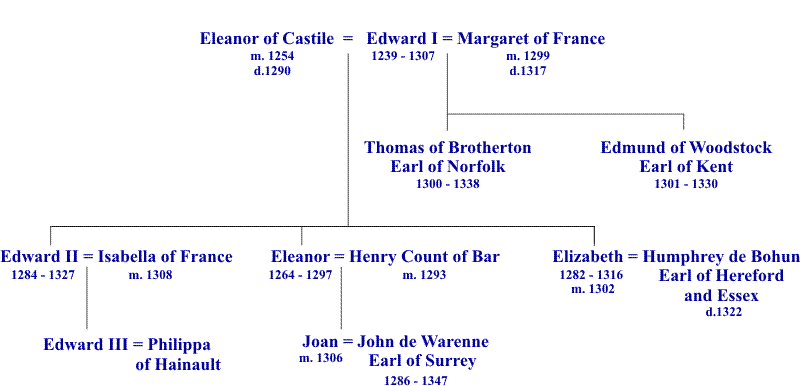
- The East Window.
- Other Heraldic Glass.
- The Tombs.
- The Funeral Hatchments.
- The Royal Arms.
| Top row | Azure a cross patonce between four martlets or. These are the arms designed by the 13th Century heralds for Edward the ConfessorAzure a cross patonce between four martlets or. ; he himself would never have borne them, as heraldic arms did not come into general use until the first half of the 12th Century. As St. Edward was one of the patrons of England it is not unusual to find these arms in Ecclesiastical buildings. |
| Second row |
|
| Third row |
|
| Fourth row |
|
In each of the panels the colour of the background is either blue or red, counter changing with the colour of the field of the arms borne thereon. Of the original nine shields five have red fields (England, the heir apparent, and Brotherton) on blue backgrounds, and four have blue fields (St. Edward, France, de Bohun, Warenne) on red backgrounds. Therefore, to conform with the probability of counter changing of colours throughout the window, it is likely that the original missing shield had a blue field (on a red background). Might this have been the arms of France repeated, for Queen Margaret the second wife of Edward I, who died in 1317?
This is indeed possible, for the Lordship of Alton Hundred was in the King’s hands, and descended with the manor of Alton Westbrook; at least from the time of Edward I who granted it first to his mother, Queen Eleanor, and then, in 1299, to Queen Margaret. Following her death in 1317, Edward II gave it to his half brother Edmund of Woodstock in 1319; Edmund was executed in 1330.
If indeed the missing shield were for Queen Margaret the window was probably made before 1317. At the same time, the use of silver stain to produce the yellow of some of the glass indicates a date after 1307. Furthermore, although it is likely that there was a previous church on the site, records suggest that the first incumbent of the present church was Walter de Berton in 1307.
If the above argument is accepted, then it is probable that the glass was placed in the church at same date between 1307 and 1317.
Another suggestion has been made that the missing shield might have been that of Edmund of Woodstock, to whom Edward II gave the Lordship of Alton Hundred in 1319. The argument against this is that his arms (England with a border argent) are borne on a red field which would break the strict counter changing of colours as explained above. If this were the solution, then one could date the window somewhat later, between 1307 and 1322, when de Bohun was killed at Borroughbridge in arms against his king.
The importance of the missing shield is considerable, but it does seem certain that the window commemorates the Lords of the Hundred of Alton with some of their relations living, and it may well have been a royal gift to the newly built church.
Finally, how were the shields originally arranged? Charles Winston, who visted the church on 18th December 1848, (see note below), refers to the glass as having been altered by Aubertin (see note below), but one is at least able to reconstruct a possible original
| Edward the Confessor | ||
| Edward II | Queen Isabella | |
| Prince Edward | Queen Margaret | Brotherton |
| Warren or de Bohun |
Joan or Elizabeth |
de Bohun or Warenne |
Elizabeth or Joan |
- These notes could not have been prepared without the great help given by Mr. John A. Goodall F.S.A.
- Charles Winston pioneered the serious study of stained glass in England and his notebooks in the British Museum include quite a long account of the glass at Froyle (Add-M.S.33847 p.209 ff). A later reference (p250) deals unsatisfactorily with the arms and the relationship of the persons commemorated.
- The Reverend Peter Aubertin and his wife were amateur glass painters living at Chipstead, Surrey; and, according to the Parish records, he was curate at Froyle from 1842 to 1862 under the Reverend Sir Thomas Miller.
- Reference is made to the window in the Victoria County History of Hampshire but some statements are not to be relied upon.
